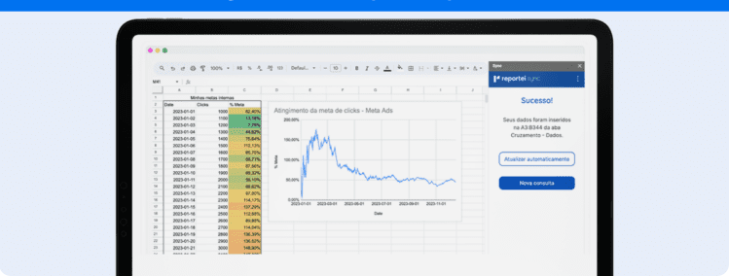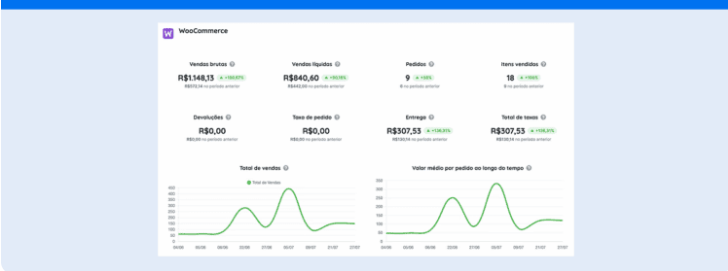Confira as 6 melhores dicas para criar um bom resumo no LinkedIn para atrair recrutadores e potenciais parceiros de negócios
Criar um bom resumo no LinkedIn é um dos passos mais importantes para quem busca se destacar na plataforma e atrair oportunidades profissionais.
No entanto, é comum que as pessoas tenham dúvidas de como começar, quais informações enfatizar e até mesmo qual tom de voz utilizar para que o texto seja ao mesmo tempo atrativo e profissional.
Sendo assim, preparamos este artigo para auxiliar nessas questões e apresentar dicas essenciais para que você possa construir o seu resumo no LinkedIn da melhor forma possível. Continue a leitura e entenda:
- O que é por que o resumo do LinkedIn é importante?
- Dicas para criar o seu resumo no LinkedIn
- Exemplo de resumo no LinkedIn
- FAQ: dúvidas frequentes sobre o campo
- Considerações finais
O que é e por que o resumo do LinkedIn é importante?
Antes de pensar em um resumo para LinkedIn, é fundamental entender a razão pela qual o “Sobre” existe e por que ele é uma peça-chave do seu perfil.
Assim como em um currículo tradicional, o resumo funciona como a sua apresentação inicial para recrutadores, colegas de profissão, clientes e potenciais parceiros de negócio.
Dessa forma, diferente de outras seções do perfil, como “Experiência e Formação”, o “Sobre” permite que você se descreva de maneira mais pessoal e contextualize suas habilidades, valores e motivações.
Ou seja, esta é a primeira impressão que muitas pessoas terão de você.
Além disso, um bom resumo tende a ser um diferencial no ranqueamento do LinkedIn, já que a plataforma utiliza palavras-chave e algoritmos de relevância para sugerir perfis a recrutadores e empresas. Por isso, caprichar no texto é fundamental!
– Leia também: Guia do LinkedIn: saiba como criar e otimizar a sua Company Page
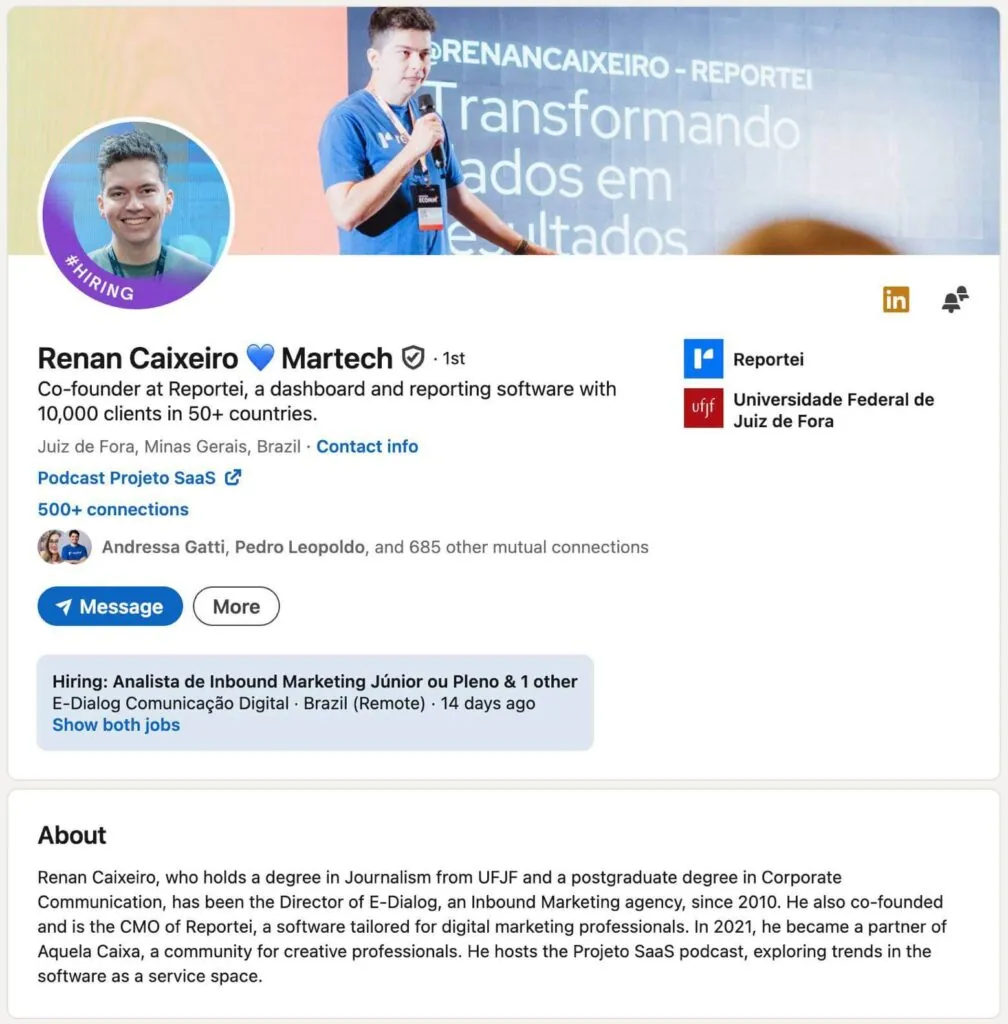
Dicas para criar o seu resumo no LinkedIn
Agora que você já sabe a importância de criar um bom resumo no LinkedIn, é hora de conferir as melhores dicas para desenvolver o seu texto de apresentação. Vamos lá?
1. Defina o tom e o estilo de escrita
Primeiramente, vamos falar sobre o tom e o estilo de escrita do seu resumo, que vão depender dos seus objetivos, bem como da cultura da área ou empresa em que atua ou pretende atuar.
Sendo assim, antes de definir o tom certo, sempre avalie questões como:
- Conhecimento do público: se a sua área for mais tradicional (por exemplo, direito), é provável que um tom mais formal seja adequado. Porém, se trabalha em setores criativos ou de tecnologia, pode-se considerar um estilo mais descontraído, mas ainda profissional;
- Autenticidade: nada afasta mais o leitor do que um texto que parece “copiado” ou que não representa de fato quem você é. Desse modo, procure demonstrar sua personalidade, seus valores e seu jeito de se comunicar. Afinal, um toque pessoal torna seu resumo mais humano;
- Equilíbrio entre linguagem técnica e acessível: use termos específicos da sua área, mas sem exagerar nos jargões. Lembre-se de que nem todos os recrutadores ou clientes podem ter o mesmo conhecimento técnico;
- Coerência com o restante do perfil: por fim, se você tem um estilo de escrita em posts ou artigos publicados no LinkedIn, tente manter a mesma linha no resumo, para que haja consistência na sua marca pessoal.
– Leia também: Linkedin Stories: dicas para integrá-lo na sua estratégia digital.
2. Conheça a estrutura ideal para um bom resumo no LinkedIn
Muitas pessoas ficam na dúvida sobre como começar a escrever o resumo no LinkedIn. Por isso, abaixo, selecionamos alguns elementos fundamentais que ajudam a dar forma ao texto:
Modelo de abertura: como capturar a atenção logo nas primeiras linhas
As primeiras duas ou três linhas são muito importantes, pois o LinkedIn exibe apenas uma prévia do seu resumo.
Dessa forma, se o leitor precisar clicar em “ver mais” para ler o texto completo, é essencial que o início seja envolvente. Portanto, uma boa prática é incluir:
- Uma frase que sintetize quem você é ou o que você faz;
- Questionamento que desperte curiosidade;
- Ou realização de destaque (por exemplo, “Responsável por aumentar em 200% as vendas online de uma startup de e-commerce”).
Confira um exemplo de abertura a seguir:
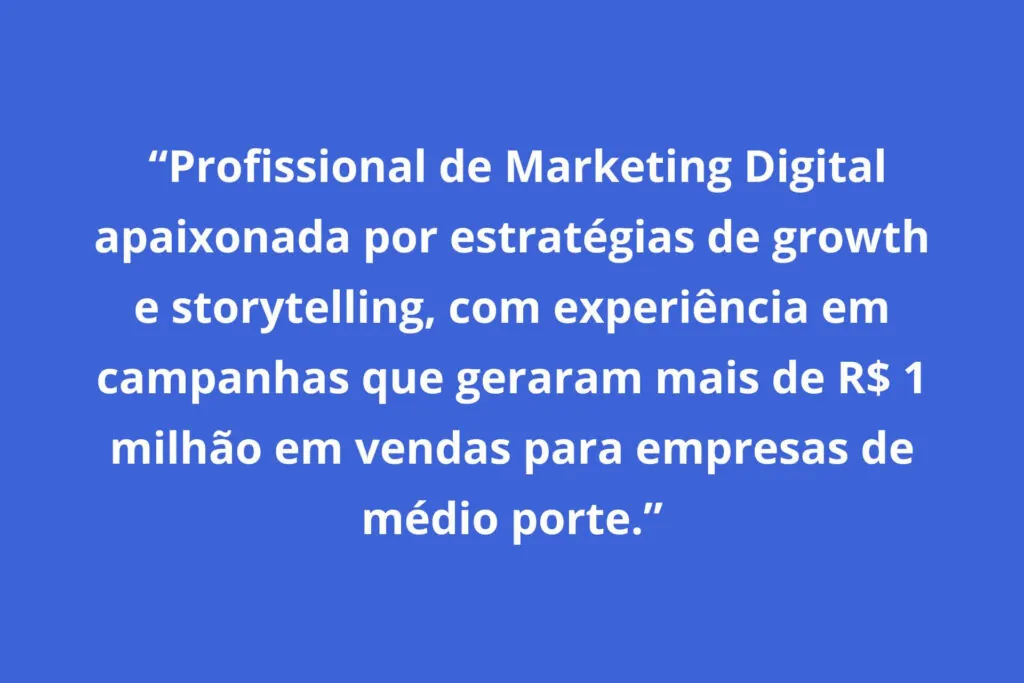
Principais informações a serem destacadas
Depois de uma boa abertura, você pode seguir com as informações abaixo:
- Formação: mencionar o curso e a instituição, mas sem estender demais;
- Experiências relevantes: foque nas áreas que mais têm relação com seu objetivo atual;
- Conquistas: cite resultados relevantes e metas alcançadas que ilustrem suas habilidades;
- Interesses de carreira: explique em que tipo de projetos ou posições você gostaria de trabalhar no futuro, deixando claro onde quer chegar.
Fechamento convidativo: incluir um “call to action”
Em seguida, termine o texto de uma forma que incentive o leitor a entrar em contato ou saber mais sobre você.
Ou seja, pode ser um convite para uma conversa, solicitação de conexão ou algo que mantenha o diálogo aberto. Veja um exemplo de fechamento:
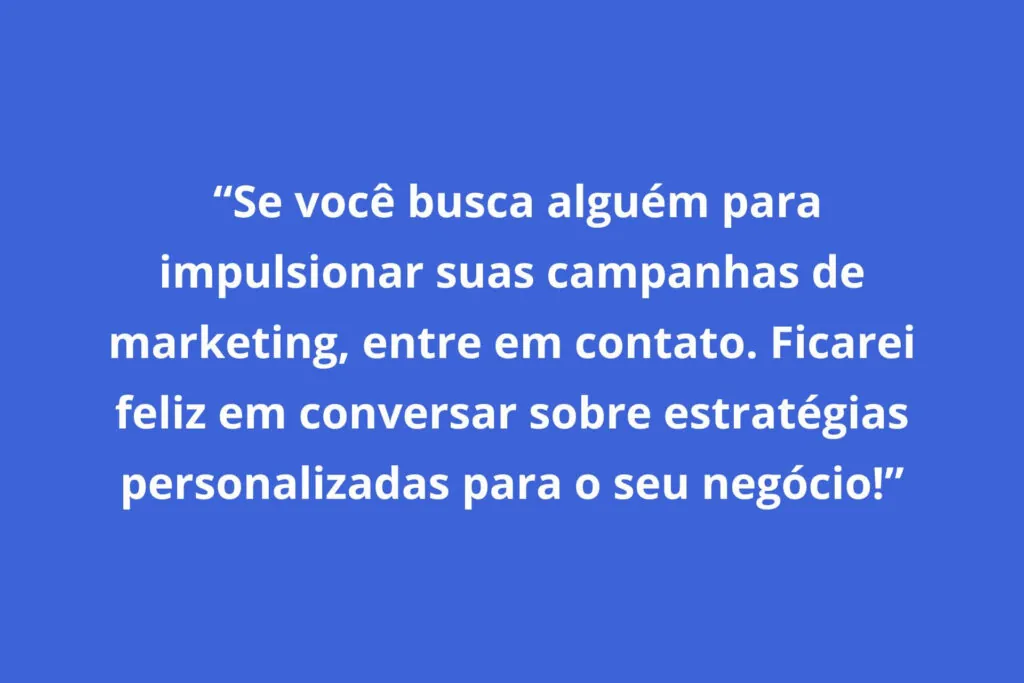
Tamanho de texto recomendável
Além disso, pense também no tamanho do texto. O LinkedIn permite um número considerável de caracteres, mas isso não significa que você deva usar tudo.
Em média, escrever entre 300 e 500 palavras costuma ser suficiente. Afinal, a ideia é não tornar o texto cansativo e manter o leitor engajado do início ao fim.
Uso de quebra de parágrafos, tópicos ou bullet points
Para facilitar a leitura, é fundamental também estruturar o texto em pequenos blocos ou tópicos.
Sendo assim, utilize parágrafos curtos, bullet points ou marcadores para destacar as principais habilidades e conquistas.
3. Destaque resultados e conquistas
Por falar nisso, uma das partes mais relevantes de qualquer resumo no LinkedIn são as conquistas e resultados que você obteve ao longo da sua trajetória.
Não basta apenas dizer “tenho experiência em gestão de equipes”. É muito mais eficaz mostrar um número ou um exemplo concreto. Portanto:
- Use dados quantitativos sempre que possível: aumento de vendas em porcentagem, economia gerada, número de pessoas lideradas, crescimento de tráfego no site, entre outros;
- Conte histórias curtas (storytelling): ao invés de apenas listar fatos, explique rapidamente o contexto e como você atuou para alcançar determinado resultado.
Confira um exemplo prático:
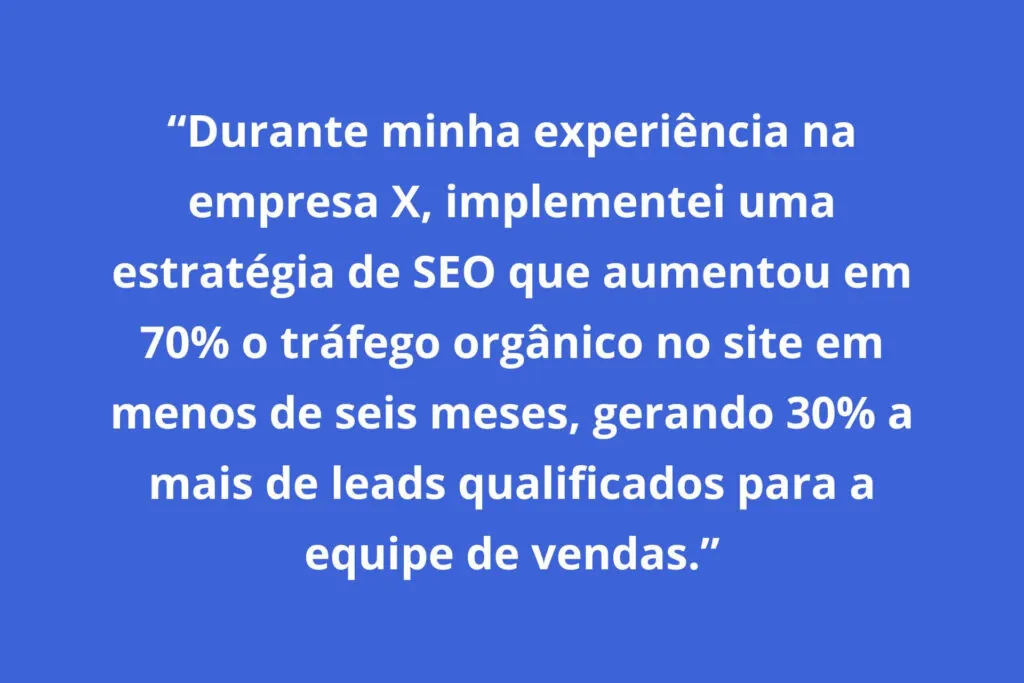
Dessa forma, o leitor consegue compreender de maneira clara o valor que você pode gerar para a organização ou projeto.
4. Use palavras-chave no resumo
Como citamos anteriormente, o resumo no LinkedIn é fundamental para o ranqueamento da sua página pessoal dentro da plataforma.
Por isso, incluir as palavras-chave certas pode fazer toda a diferença para que recrutadores e potenciais clientes encontrem você. Dessa forma, é essencial:
- Pesquisar termos relevantes na sua área: como “marketing digital”, “desenvolvimento de software”, “gestão de projetos”, entre outros;
- Evitar exageros: inserir muitas palavras-chave sem contexto pode deixar o texto mecânico e pouco atrativo;
- Ser estratégico: mencione as habilidades e competências mais importantes logo no início do resumo, mas também as repita de forma natural ao longo do texto.
Lembre-se, ainda, de que palavras-chave não se limitam a competências técnicas.
Dessa maneira, se você utiliza metodologias específicas em seu trabalho (como Scrum, Kanban ou Design Thinking), vale a pena incluí-las no “Sobre”.
5. Alinhe o texto com seus objetivos de carreira
O resumo no LinkedIn deve refletir não apenas o que você fez no passado, mas também para onde deseja ir.
Por exemplo, caso esteja em transição de carreira, é importante usar esse espaço para explicar o que motiva essa mudança e o que pretende fazer no novo setor. Com isso:
- Seja claro sobre suas aspirações: mencione o tipo de posição que busca ou a área em que deseja crescer;
- Mostre conexão entre o passado e o futuro: explique como suas experiências anteriores podem agregar valor na área que você deseja atuar;
- Adapte o vocabulário: use termos relacionados ao seu novo objetivo para que o texto reflita sua motivação e seja encontrado por recrutadores que buscam esse perfil.
Um exemplo de texto focado na transição de carreira é:
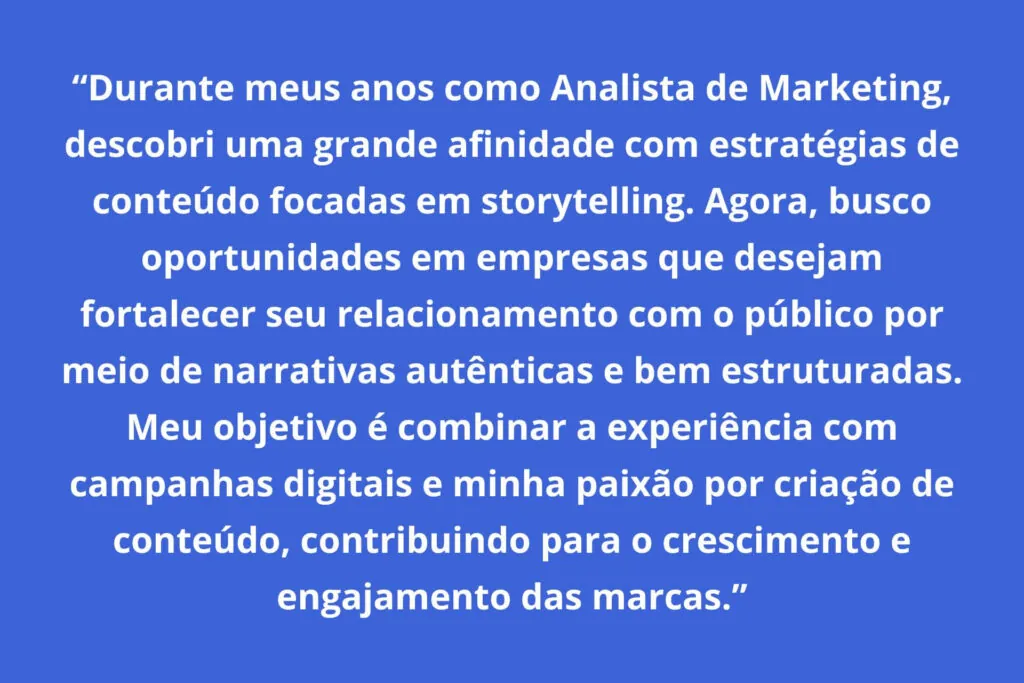
6. Evite os erros mais comuns
Por fim, é essencial estar atento aos erros comuns na hora de criar um resumo no LinkedIn e evitá-los ao máximo. Os principais são:
- Texto muito genérico: frases como “Sou um profissional dedicado, responsável e comprometido” podem soar vazias. Portanto, mostre evidências concretas que comprovem essas qualidades;
- Foco apenas em habilidades técnicas: não se esqueça de mencionar sua personalidade, valores e características que vão além do que está em um certificado ou diploma;
- Ausência de um fechamento convidativo: se você não disser ao leitor o que gostaria que ele fizesse (conectar, enviar mensagem ou acessar seu portfólio), pode perder oportunidades valiosas de contato;
- Quantidade excessiva de texto: um resumo muito longo tende a afastar o leitor. Sendo assim, estabeleça prioridades e faça uso de parágrafos curtos;
- Falta de revisão ortográfica e gramatical: erros de português passam uma impressão de desleixo. Então, antes de publicar, revise e, se possível, peça para alguém ler e verificar se tudo faz sentido.
– Leia também: Como programar post no LinkedIn? Confira tutorial completo
Exemplo de resumo no LinkedIn
Confira a seguir um exemplo de resumo no LinkedIn pronto:
“Profissional de Marketing Digital apaixonada por estratégias de growth e storytelling, com experiência em campanhas que geraram mais de R$ 1 milhão em vendas para empresas de médio porte
Durante meus anos como Analista de Marketing, descobri uma grande afinidade com estratégias de conteúdo focadas em storytelling. Agora, busco oportunidades em empresas que desejam fortalecer seu relacionamento com o público por meio de narrativas autênticas e bem estruturadas. Meu objetivo é combinar a experiência com campanhas digitais e minha paixão por criação de conteúdo, contribuindo para o crescimento e engajamento das marcas.
Se você busca alguém para impulsionar suas campanhas de marketing, entre em contato. Ficarei feliz em conversar sobre estratégias personalizadas para o seu negócio!”
FAQ: dúvidas frequentes sobre o campo
Confira a seguir as principais dúvidas sobre o “Sobre” no LinkedIn:
O resumo é a sua apresentação pessoal no LinkedIn. Ele funciona como a primeira impressão para recrutadores, clientes e parceiros, permitindo contextualizar quem você é, quais suas habilidades, valores, motivações e objetivos de carreira.
O resumo aparece na seção intitulada “Sobre” do perfil, logo abaixo da foto, título (headline) e informações básicas, com as primeiras duas ou três linhas exibidas como prévia e o resto acessível em “ver mais”.
O campo tem um limite de caracteres em torno de 2.600 caracteres, por isso vale conferir no momento da edição e escrever de forma estratégica (usar termos-chave e priorizar clareza nas primeiras linhas).
Priorize uma abertura que sintetize quem você é e o que faz, destaque formação e experiências mais relevantes, cite resultados e conquistas quantificáveis, demonstre interesses e objetivos de carreira e finalize com uma call to action.
Estruture o texto começando por uma frase de impacto nas primeiras linhas, siga com pontos que comprovem seu valor (formação, experiências e resultados), use parágrafos curtos ou bullets para facilitar a leitura, inclua palavras-chave da sua área e termine com um convite claro para contato. Não esqueça de revisar a ortografia e adaptar o tom ao seu público.
Foque em potencial e elementos que substituem a experiência: descreva objetivos de carreira, projetos pessoais, cursos e formações, atividades extracurriculares, habilidades transferíveis, resultados de trabalhos acadêmicos ou voluntariado e mostre atitude (disposição para aprender, áreas que deseja explorar, etc).
Considerações finais
Ter um bom resumo no LinkedIn é uma forma de destacar suas habilidades, diferenciais e objetivos de maneira mais pessoal, indo além do que apenas o histórico de experiências consegue mostrar.
Por isso, seja você iniciante na plataforma ou alguém em busca de melhorar seu perfil atual, vale a pena investir tempo para criar um texto que reflita sua personalidade e, ao mesmo tempo, evidencie suas competências e aspirações de maneira clara.
Mas lembre-se de que não existe fórmula mágica: o melhor resumo é aquele que comunica verdadeiramente quem você é e o valor que pode oferecer.
Gostou das dicas que selecionamos para ajudar a escrever o “Sobre” do seu perfil do Linkedin? Então aproveite para ver também nosso vídeo sobre a criação de conteúdo para a rede:

